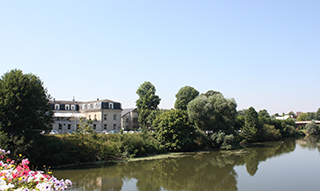Prochain point : lat="49.00183" lon="1.909691"

Fort Island
The heart of Meulan until the late nineteenth - early twentieth century
From Place Létang...
Once the beating heart of the town, protected by its ramparts, Place Létang was the administrative and religious centre, with two churches dedicated to Saint-Nicaise and Saint-Jacques as well as a hospice. All that remains of the former site is the square, Place Létang, with the home of the famous Baron of the Empire, Hôtel Lévrier, rue Saint-Jacques and rue François de Blois, a few medieval houses and the vestiges of the ramparts.
In front of the house of Baron Létang there is preceded a courtyard where a beautiful garden contains an ancient grape vine and a splendid Ginkgo Biloba tree native to the Far East whose leaves turn a rich yellow in the fall and form a golden carpet at its feet. In the 1920s, the leaves were a source of inspiration for Art Deco style motifs.
... To the remains of the great bridge
A bridge, built in 1240, once connected the fort island to Mureaux. Vestiges of the bridge can be seen on the banks of the Seine on Bailiwick quay. The bridge was destroyed in 1944 by Allied troops to cut off the Germans. Some beautiful homes built in the nineteenth century still remind us of its former glory.
Gustave Ravanne
A post-Impressionist painter who loved marine landscapes
From the banks of the Seine in Meulan...
Léon Gustave Ravanne was born in Meulan on September 30, 1854. His father was a butcher in rue Basse (now rue du Maréchal Foch) and they say he used to sketch landscapes in the back of the shop, including the old streets of Meulan. He was a student of Leon Bonnat and then of Fernand Cormon, and opened a studio in Paris and in Les Mureaux.
... To the Normandy coast
In 1896, he was appointed as the official painter of the Navy. He remained very attached to Meulan, which was the subject of one of his finest masterpieces "The bridge of Meulan" painted in 1887 and still on display in the Council Chamber. He was made a Knight of the Legion of Honour in 1900 and died in his studio in Les Mureaux on October 14, 1904, at 9 bis, rue Victor-Hugo. He was part of the Post-Impressionist movement and deserves to be better known as his work is so rich.





